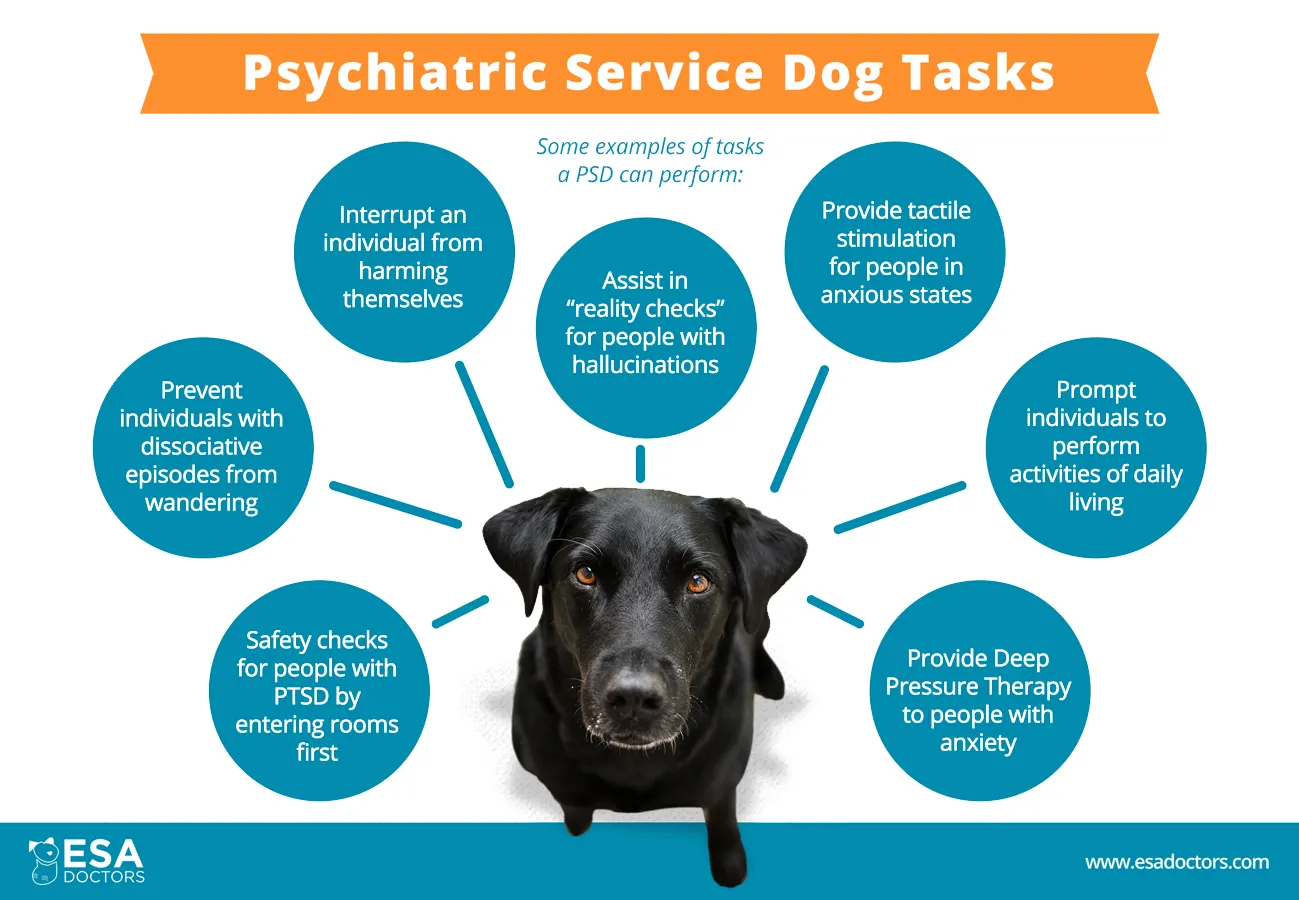If you’re currently seeing a therapist or a doctor to treat an emotional or mental condition, then you might be wondering, “Do I qualify for a psychiatric service dog?” The answer isn’t cut and dry, but there are a few facts about psychiatric service dogs that help you determine if you qualify.
What is a Psychiatric Service Dog?
Psychiatric service dogs (PSD) fall under the Americans with Disabilities Act (ADA) definition of a service dog. PSDs assist people with psychiatric disabilities, like post-traumatic stress disorder (PTSD), anxieties, depression, and schizophrenia. These dogs perform tasks that enable people with psychiatric disorders to manage day-to-day life. A few examples of tasks that psychiatric service dogs carry out are:
- Execute safety checks for people who have PTSD by entering a room first and checking the area.
- Preventing individuals who have dissociative or anxiety episodes from wandering or from entering dangerous areas.
- Interrupting an individual from harming themselves.
- Assist in “reality checks” for people with hallucinations, by confirming if a person they see is actually present.
- Provide tactile stimulation for people in catatonic or anxious states.
- Prompt individuals to perform their activities of daily living, such as bathing, eating, and taking medicine.
- Awaken individuals when they are having disturbing nightmares.
- Provide Deep Pressure Therapy (DPT) to people with anxiety, helping reduce stress levels.

What is a Psychiatric Disability?
The terms psychiatric disability, mental illness, and psychiatric disorder are often used interchangeably. Though the terms are similar, their appropriate use depends on the context in which they are used.
According to the ADA, mental illness is typically used in a healthcare context, referring to emotional or mental health conditions. The term psychiatric disability, however, is more for use in legal issues or policymaking when referring to conditions covered by the ADA. In short, the ADA defines a psychiatric disability as “a physical or mental impairment that substantially limits one or more major life activities.”
For example, everyone feels stress every so often. Intermittent stress is a universal experience and occurs with everyone. On the other hand, severe anxiety is not a universal experience. Severe anxiety can last for long periods, making it difficult for an individual to work or do well in school. A psychiatric disability holds a person back from carrying out life activities.
If you are interested to know if you qualify for a Psychiatric Service Dog, we are happy to connect you with a licensed healthcare provider so they may evaluate your condition.
If your mental disorder qualifies as a disability, a healthcare provider will issue a Psychiatric Service Dog Letter for you.
Does a Psychiatric Disability Qualify You for a Psychiatric Service Dog?
Whether or not a psychiatric disability qualifies a person for a psychiatric service dog depends on how the disability presents itself in an individual — and if a psychiatric service dog can help reduce symptoms and accomplish the tasks a person can’t do on their own.
What makes a service dog vital is its trained ability to perform specific tasks. Unlike emotional support animals (ESA), whose presence provides comfort and support for people with mental or emotional disorders, service dogs receive extensive training. The training they obtain targets particular tasks, like retrieving medication or prompting a person to stop injuring themselves. Dogs don’t become psychiatric service dogs because their owner has a psychiatric disability. Dogs become psychiatric service dogs because they undergo months (sometimes years) of extensive training to perform specific psychiatric disability-related tasks.
That said, a person qualifies for a psychiatric service dog if there is an essential task that their psychiatric disability prevents them from doing safely or efficiently. A service dog could perform that task for them. For example, a person with anxiety might find that their panic attacks prevent them from working. A service dog trained to offer tactile stimulation — preventing panic attacks — could help them prevent the episodes at work and allow them to keep their job.
The key to determining the qualifications for a psychiatric service dog is:
- The person must have a psychiatric disability.
- A service dog can be trained to perform one or more tasks that specifically helps to manage the person’s psychiatric disability.
Because psychiatric disorders vary in each individual, it’s best to consult with a treatment provider. Their doctor or therapist might find that a psychiatric service dog can benefit their quality of life.
Do You Qualify for a Psychiatric Service Dog?
When people think of service dogs, very often guide dogs for the visually impaired and mobility support dogs come to mind. Thankfully, service dogs can work with people with psychiatric disabilities. If you have a psychiatric disorder, working with a PSD could make all the difference. If you’re interested, consult with a doctor or therapist to determine if a psychiatric service dog can help.








Hello, how long does it take to receive a PSD letter after filling out the form and paying for the order?
That depends on the particular LMHP you are assigned to. Please reach out to our support team (support@esadoctors.com) with the state you live in and they will be able to give you a more precise response.